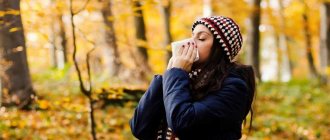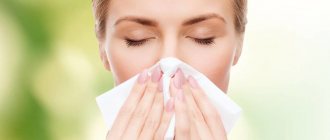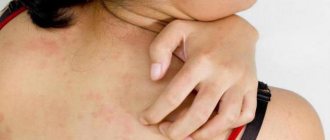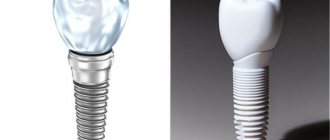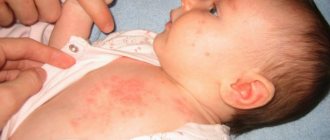General information
Allergic pathology throughout the world is one of the global medical and social problems, the prevalence of which is growing every year and, according to international epidemiological studies, has acquired pandemic . Of significant importance in the structure of allergic diseases of people of different ages is hay fever , which is an allergic disease caused by pollen of various plants, which is based on an immediate allergic reaction.
The disease is caused by the development of a specific IgE-dependent reaction caused by exposure to pollen allergens, and is characterized by acute inflammatory changes mainly at the level of the mucous membranes of the respiratory tract and eyes. The production of specific IgE antibodies occurs during the first contact with the allergen, which bind directly to the receptors of mast cells, contained in the mucous membrane/submucosal layer and airways in large quantities. In cases of repeated contact with a specific allergen, degranulation of target cells and the release of highly active substances ( cytokines , histamine , platelet activating factor, leukotrienes) in large quantities are observed. As a result, the permeability of membranes increases, the vessels of the mucous membranes dilate, and the migration processes of cells to the site of inflammation intensify, which leads to the development of characteristic symptoms.
According to various sources, from 2% to 36% of the world's population suffers from hay fever, while the incidence rate of hay fever doubles every 10 years. People aged 10-40 years are most often affected. In Russia, the incidence varies between 12.8-24.0% depending on the region.
The first symptoms most often manifest at the age of 8-20 years, but the disease can also develop in both younger children and people of older age groups. The incidence among urban residents exceeds the incidence among rural residents by 4-6 times. The frequency of hay fever can vary significantly depending on the climatic and geographical zones of the Russian Federation, which is due to the different nature of vegetation; climatic features; anthropogenic specifics of regions (chemical pollution of soil, air, water); population factors (nature of nutrition/work, religious/ethnic characteristics).
Hay fever (pollen allergy) in most cases is caused by pollen of wind-pollinated plants (anemophilous), since it is light, small (up to 35 microns) and can be transported by gusts of wind over considerable distances. Wind-pollinated plants include most trees (oak, ash, birch, poplar, hazel, alder, hazel, willow, maple), cereal plants (corn, rye, wheat, oats, timothy, fescue, brome, wheatgrass, ryegrass, foxtail, bluegrass and etc.) and asteraceae (dandelion, wormwood, ragweed, etc.)/chenopodiaceae (cyclamen, quinoa, hemp) herbs. While the pollen of plants pollinated by insects (entomophilous) is released into the air in small quantities, the pollen grains themselves are larger in size and are practically absent from the air during the dusting season. The ability of pollen to cause allergies is determined by:
- The presence in the air (during the flowering period of the plant) of a high concentration of pollen (the number of grains of at least 30/1 cm of air leads to an outbreak of hay fever).
- A high content of glycoproteins/protein in pollen grains, which are the male gamete of the plant, that is, they have pronounced antigenic activity.
- A pollen permeability factor that promotes the penetration of pollen into the submucosal layer through the epithelium of the mucous membranes, where lymphoid follicles containing B and T lymphocytes are located.
Pollen from wind-pollinated plants has a complex antigenic composition and in some plants it can contain up to 5-10 allergenic components. It is important to consider that antigenic proteins may be contained in other parts (leaves, seeds, fruits, stems) of the plant, which causes intolerance to herbal preparations in many patients with hay fever. Diseases develop with increased sensitivity (sensitization) to the effects of environmental factors, which are weed pollen. The herbs with the most pronounced allergenic activity include ragweed and wormwood.
Currently, an extremely important problem is the influence of environmental factors on natural exoallergens and their change (increased pollen allergies) under the influence of substances contained in the atmospheric air: sulfites, nitrates, ammonia, chlorine, oxygen radicals, fluorine, xenobiotics, diesel fuel combustion products , carcinogens and many others. Atmospheric and environmental pollution changes the antigenic structure of pollen, prolongs the time of plant palination and increases its allergenicity.
The ability of pollen contaminated with unfavorable factors to induce more pronounced sensitization of the body and reactivity of the mucous membrane of the upper respiratory tract has been established. Phytotoxicants, when combined with their increased concentration in the atmosphere, increase the viability of grass pollen and cause an increase in the incidence of hay fever in the population of industrial regions. Disturbance of natural landscapes caused by the transformation of territories contributes to the reduction of the habitats of habitual habitats of plant species and, as a consequence, to the wide distribution of weeds. Evidence has emerged of the emergence of hypersensitivity to plants to which it had not previously been noted.
Despite the fact that hay fever is not a condition that directly threatens human life, its presence significantly worsens the quality of life of patients.
No Allergies!
An allergic reaction to ragweed is the body’s response to the pollen that is formed during the flowering period. This type of allergy is considered one of the most aggressive; everyone suffers from it: men, women and children at any age. Therefore, it is not surprising that many are wondering how to treat ragweed allergies?
The main symptoms, in addition to a runny nose and sneezing, include rashes on the epidermis, skin itching, and burning. It is necessary to begin treatment for allergies to ragweed as soon as possible, each type of which is discussed below.
You may also be interested in:
- Whether or not to use antibiotics for boils
- Pemphigus vulgaris - causes, symptoms, treatment read here
- Problems with the immune system can cause oral disease - lichen planus https://idermatolog.net/boleznikogi/dermatiti/zabolevanie-polosti-rta-krasny-j-lishaj.html
As part of restoring optimal health with the help of medications, antihistamines such as diphenhydramine and suprastin, loratadine are used. Speaking about pills for ragweed allergies, it should be noted that:
Diphenhydramine gel is another best remedy for ragweed allergies that can be used by both adults and children. It is applied to the most affected areas: the wings of the nose, near the mouth, possibly near the eyes, but very carefully twice a day in a thin layer and rubbed until 100% absorption.
Modern injections for ragweed allergies are called “specific immunotherapy” (ASIT) and will help significantly improve your health. They involve the introduction of a concentrated allergen (in this case, ragweed) into the patient’s blood, which will help the body get used to and cope with it.
The treatment algorithm is conventionally divided into three categories according to the speed of impact:
- accelerated , in which the allergen is introduced 2-3 times a day
- lightning fast – the required dosages are introduced within 3 days with breaks of 180 minutes
- shock method - in this case, injections are carried out for 24 hours every 120 minutes
When treating allergies to ragweed in children under 5 years of age, these injections are contraindicated, and above this age - according to exactly the same algorithm as for adults.
In 90% of cases, people experience significant improvements in well-being. Therefore, this is the best way to answer the question of how to get rid of an allergy to ragweed. It is worth noting that an injection for ragweed allergies is given by the drug diprospan , which is used in cases where tablet drugs do not have the desired effect.
The product is used for both adults and children at any age. From 1 to 2 ml per day is injected into the muscles. In all other cases, consultation with specialists is necessary, because dosages can be very different.
There are contraindications for any type of injection: gastritis, peptic ulcers, kidney and liver failure.
Another type of therapy is symptomatic, it involves the use of new generation ragweed allergy medications:
nasal sprays:
- Beconase can be used by adults and children over 6 years of age, 2-3 sprays into both nostrils daily for 7 days. If the desired effect is not achieved, use should be discontinued.
- Nasonex - nasal drops for ragweed allergies can be used by people over 12 years of age, no more than two inhalations into each nostril per day (once). Children from 2 to 11 years old – 1 inhalation every 36 hours
eye drops for ragweed allergies:
- dexamethasone-lance - use by children is contraindicated. For adults over 16 years old, twice a day (morning and evening) no more than 4 mg
- optive - eye drops for allergies to ragweed are prescribed to children from 3 years of age no more than 5 mg per day, adults - from 4 mg per day or more, depending on the severity of allergic manifestations
The presented drugs are prescribed exclusively for aggravated disease, as well as in the event that there is no visible effect from the use of antihistamine-type drugs.
In order to know exactly how to deal with ragweed allergies and protect yourself as much as possible from seasonal manifestations, you should start therapy 10-14 days before the likely “start” of an exacerbation.
You can also treat an allergy to ragweed with folk remedies; read how to do this here.
An important condition is the diet if you are allergic to ragweed. This is because some plant varieties that are related can significantly worsen the disease. Experts assure that if you have an allergic reaction to the pollen of the described plant, it is not advisable to eat foods such as banana, melon, watermelon and cucumbers. In some cases, a severe allergy is possible - to the pollen of plants such as sunflower and dandelion.
In addition, dietary nutrition excludes the use of components such as:
In order to know how to cure an allergy to ragweed forever, it is important to remember that patients should not consume large quantities of smoked foods and products with a significant ratio of any chemically active substances.
Thus, an allergy to ragweed in a child and an adult is an extremely unpleasant process that is quite easy to treat.
Surely, if you suffer during the ragweed bloom, you want to find a truly effective remedy for your ragweed allergy.
It is very difficult to endure another season of flowering of this plant. Constant cough, runny nose, incessant sneezing, swollen, red eyelids... Unfortunately, this list of symptoms is regularly supplemented by such an unpleasant phenomenon as a fairly high temperature.
Is there an effective treatment for ragweed allergies? Of course, there are many drugs that can block histamine, which causes so much discomfort to allergy sufferers. Most of them can act for up to 24 hours, but the patient will have to take the “dose” again the next day.
Please note that so-called 1st generation drugs (for example, diphenhydramine) cause drowsiness. But they also cost less than 2nd and 3rd generation drugs that are free of this effect (medicines that include claritin, loratadine). The latter, by the way, have a cumulative effect, allowing you to avoid acute manifestations of allergies. In addition, they also come with various types of sprays for the nose or eyes.
The fight against ragweed allergies involves a number of measures. First of all, be sure to confirm your diagnosis with an allergist. This is done in several ways: using skin tests, when the allergen is applied under the skin (it cannot be done during the flowering period of ragweed), or diagnostics using antibodies - in this case, your blood will be used for tests, which will be applied to a special panel with various allergens .
In addition to taking medications, it is important to follow some rules to alleviate your condition. First of all, forget about herbal medicine - anything related to herbs will become real poison for a person with an allergy to ragweed. Wear sunglasses in summer to prevent pollen from coming into contact with your eyes. Ventilate the room less often; if possible, install an air conditioner with an ionizer in the apartment.
Your best remedy for ragweed allergies is water. Take a walk after the rain, when there is a minimum of pollen in the air, spray the curtains with water. Wash every day and be sure to rinse your nose with water after going outside. When outside, use wet wipes to blot your skin. Wipe your furniture with a damp cloth every day, especially often with your desk.
Unfortunately, the answer to the question “how to cure an allergy to ragweed” simply does not exist. You are unlikely to be able to get rid of it completely, but you can suppress it for several years. To do this, you will need to undergo a course of special immunotherapy.
Its peculiarity is that it should be carried out when the allergen cannot disturb you. That is, early winter or late autumn. Its meaning is that a person is given a drug with ambrosia, but there is as much of it as the body can process without consequences for it.
The procedure is carried out over six months - as a result, the body stops reacting sharply to the allergen. After this “immunotraining” you will forget about your problem for up to 4 years. However, after they expire, the procedure will need to be repeated again. And such a “remedy” for ragweed allergies is much better than regularly taking antihistamines during the flowering period of the plant.
Allergies today are becoming perhaps the most common disease. If you don’t have this problem directly, you’ve probably seen someone close to you suffer from a runny nose, sneezing and constant watery eyes. As practice shows, allergy to ragweed is most often diagnosed - an ailment for which not any medicine helps. Knowing the methods that have already been tried, it will be much easier to save yourself and your loved ones from the unpleasant symptoms of the disease.
Ambrosia is a weed that is found in almost all regions. Most of the summer the plant does not pose a health hazard. The worst thing begins during the flowering period, when it throws out panicles covered with pollen. It is the latter that is a very strong irritant, which, in addition to everything else, is easily carried away by wind currents.
As soon as pollen gets on the skin or mucous membranes, many people experience sensitization. During repeated contact with the irritant, the immune system intensively begins to produce antibodies, immunoglobulin E and mast cells are formed. All this taken together leads to allergic attacks.
You can understand that you need medicine for a ragweed allergy when the following symptoms appear:
- lacrimation;
- attacks of bronchial asthma;
- redness of the eyes;
- itching;
- runny nose;
- rhinorrhea;
- nasal congestion;
- dry cough;
- frequent headaches;
- sudden changes in mood;
- congestion in the ears.
Despite the fact that some skeptical experts are confident that treating ragweed allergies is a waste of time, patients do not give up. To be frank, it is really difficult to cure an illness such as allergies, but it is still possible to alleviate the condition and eliminate some of its symptoms with the help of medications.
Of course, the best medicines for ragweed allergies are antihistamines. Most of them relieve allergy symptoms within a few minutes after consumption.
Depending on how long ago they were developed, all medications can be divided into several generations:
1. The most famous and effective first-generation ragweed allergy medications are:
- Diazolin;
- Fenkarol;
- Diphenhydramine;
- Pilpofen;
- Suprastin.
In addition to the fact that these medications stop allergy attacks, they have a powerful antispasmodic effect.
2. The more advanced second generation of antihistamines are absorbed very quickly by the body and act for quite a long time. At the same time, drugs do not penetrate the blood-brain barrier. Among the representatives:
- Loratadine;
- Astemizole;
- Fenistila;
- Terfenadine.
The main disadvantage of representatives of this group is that they can negatively affect the heart.
3. The newest medications for ragweed allergies are representatives of the third generation:
- Telfast;
- Desloratadine;
- Levocetirizine.
Vasoconstrictor or hormonal nasal drops help to cope with an annoying runny nose:
- Eucazoline;
- Knock spray;
- Nazol;
- Rinoclenil;
- Beclazon;
- Alcedin.
For severe lacrimation from an allergy to ragweed, medications in the form of eye drops can effectively help:
- Ketotifen;
- Optivar;
- Patanol;
- Zaditor.
Injectable medications help treat ragweed pollen allergies quite effectively. The essence of this treatment is quite simple: in accordance with a certain scheme, the patient is injected with an allergen. The dosage of the injection is small, so it does not cause harm to the body, but the procedure helps to develop immunity and resistance to a particular irritant.
Ragweed is a ubiquitous weed. The fight against this plant is waged every year, but it is often not humans who win. Many patients with hypersensitivity of the body await the onset of summer with fear: it is during this period that the weed blooms, and the allergy to ragweed again clearly manifests itself.
How to treat hay fever? How to protect the body from exposure to dangerous pollen? What drugs and folk remedies effectively stop attacks of an allergic reaction? The answers are in the article.
- Causes
- First signs and symptoms
- Diagnostics
- Effective treatments
- Ten rules for protecting yourself from pollen
- Drug therapy
- Folk remedies and recipes
A negative response from the body occurs when certain receptors come into contact with pollen from a weed. Ambrosia is one of the most powerful irritants: adults and children know about the dangers of this grass, sanitary services regularly fight the plant, but the weed often sprouts again.
The smallest particles of the allergen easily penetrate the nose, mouth, eyes, and throat. Patients with hypersensitivity to irritants react sharply to pollen, but people in good health, in the absence of a tendency to allergies, are practically not bothered by ragweed blooms.
The next stage is the activation of certain processes in the body:
- mucosal reaction: release of histamine and bradykidin;
- macrophage cells begin to fight allergens;
- increased vascular permeability leads to the penetration of some blood components into the space between cells, tissues swell;
- mucus and water contain inflammatory mediators that enhance negative reactions;
- the action of biologically active substances, the migration of mast cells provokes lacrimation, sneezing, nasal congestion, allergic rhinitis and conjunctivitis.
What is Stevens-Johnson syndrome and how to treat the allergic disease? We have the answer!
For an explanation of the results of the pediatric allergen panel, see this page.
Factors that increase sensitivity to allergens:
- weak immunity;
- contact with pollen from weeds, milkweed, alder, birch, poplar fluff, presence of allergenic plants near the house;
- bad ecology;
- presence of chronic diseases;
- varicose veins, venous insufficiency;
- There are relatives in the family who suffer from allergic diseases.
Residents of areas where there are thickets of ragweed often receive local immunity to dangerous pollen: the body gradually adapts to the proximity to the weed. People living in areas where ragweed practically does not grow experience a greater allergic load when in contact with the irritant, and negative symptoms become more pronounced.
An allergy to ragweed is easy to recognize:
- sore throat, sore throat;
- frequent sneezing;
- tears are produced profusely;
- the conjunctiva turns red;
- the mucous membranes swell, with a severe reaction swelling of the larynx occurs, the person wheezes and suffocates;
- clear mucus that resembles water flows from the nose;
- the eyelids become swollen, itchy, and red.
Hay fever is often accompanied by additional symptoms:
- lips become swollen;
- the skin in the nasolabial triangle turns red, irritation appears, microcracks from frequent use of a handkerchief, the action of liquid secretions;
- sleep deteriorates;
- taste preferences often change;
- often the patient’s sense of smell decreases;
- depression, nervousness are frequent “companions” of a chronic allergic reaction;
- appearance deteriorates, the patient finds it difficult to do without a handkerchief.
Allergy to ragweed in children has similar symptoms. With weak immunity in children, reactions may be more severe.
Many people, at the first attack of allergy to ragweed pollen, think that they have a cold, instill ordinary nasal medications, drink cough tablets, vitamins, but the condition does not improve. With allergic rhinitis and conjunctivitis, the temperature rarely rises, the nature of the mucous discharge from the nose does not change, and antiviral medications do not help.
If after two or three days there are no positive changes after taking a standard set of cold medications, then it’s time to see a therapist. If hay fever is suspected, the doctor will refer you for a consultation with a specialist – an allergist.
To confirm the diagnosis, several types of studies are performed:
- special tests for allergens;
- skin tests or prick tests;
- Immunoblotting is a modern method for determining an allergen using a blood test using an original technique.
Important! The first stage of diagnosis is a conversation with the patient. The patient’s task is to provide more information about the nature of the course of the allergic disease, periods of exacerbations, frequency, and duration of attacks. Information about allergies in the family, the state of the immune system, chronic pathologies, and diseases of an allergic nature suffered at an early age will be useful.
Effective treatments
If hypersensitivity to ragweed pollen is confirmed, therapy should be started immediately. Long-term irritation of histamine receptors provokes an increase in negative symptoms, appearance deteriorates, and the patient cannot study and work calmly. Treatment is carried out under the supervision of an allergist; uncontrolled use of medications is prohibited.
Syrups and allergy drops are suitable for children, tablets are suitable for schoolchildren and adults. Injections of antihistamines are rarely done: with hay fever (a chronic type of allergy), pronounced swelling occurs less frequently than with acute forms of the disease due to the body's hypersensitivity.
If you follow the recommendations, you are less likely to develop an allergy to ragweed:
- Ventilate your home less often during the flowering period of a dangerous weed; hang a damp cloth on the window to trap pollen.
- It is better to walk after rain or in damp weather, when pollen settles on the ground.
- Every day it is necessary to use a vacuum cleaner and wet cleaning of the apartment.
- Before flowering begins, you need to destroy the weeds near the house: call the sanitary service or carry out the fight together with your neighbors.
- Upon returning home, thoroughly dry your feet, remove outer clothing, wash your clothes, wash, take a shower, rinse your mouth, and rinse your nose with salted water. Simple measures remove allergen microparticles.
- Regular glasses or sunglasses help protect your eyes in summer.
- Contact lenses must be washed twice a day with a special solution to remove irritant particles.
- The best option is to set the drying mode in the washing machine, and do not hang clothes and linen outside, where pollen easily settles on them.
- Wash your pets thoroughly after walks and comb out their fur: particles of allergens remain on the body and thick coat.
- It is advisable to remove carpets, soft toys, floor runners, thick curtains, trinkets, and sofa cushions that accumulate dust from the home. Dust mites, waste products of parasites, irritate the mucous membranes of the nasopharynx and eyes, and increase the manifestations of hay fever.
Medicines are prescribed exclusively by an allergist , depending on the individual reaction to ragweed. You will need a complex of medications: signs of a pollen allergy usually appear simultaneously in different areas. The best result of therapy will be with a combination of eye and nasal drops, tablets that block the response of histamine receptors, and hormonal compounds (for severe forms of the disease).
Effective groups of drugs:
- antihistamines. For the chronic course of allergic diseases, formulations with a delicate effect that do not provoke drowsiness are prescribed. Modern tablets, drops and syrups for allergies contain a minimal concentration of the active substance and rarely cause negative reactions. Claritin, Loratadine, Aleron, Cetirizine, Zyrtec, Eden. In case of severe swelling, swelling of the larynx, and the development of angioedema, 1st generation drugs with a rapid antihistamine effect are needed: Tavegil, Suprastin, Diphenhydramine;
- nasal drops. It is important not only to eliminate nasal congestion, but also to prevent further swelling of the mucous membranes and reduce the volume of clear mucus. Drops help well: Ketotifen, Evkazolin, Nazol. In case of pronounced reactions, medications containing hormones are prescribed. Anti-inflammatory drops Beconase, Aldecin, Beclazon have a positive effect;
- eye drops. The solution reduces the manifestations of allergic conjunctivitis, relieves itching, relieves swelling and watery eyes. Effective compositions: Zaditor, Patanol, Optivar;
- systemic glucocorticosteroids. Allergy tablets with a pronounced anti-inflammatory effect are prescribed only for severe hay fever and low effectiveness of non-hormonal drugs. The course of treatment is limited - no more than a week, the dosage and frequency of use must be strictly observed: overdose, uncontrolled use - the cause of complications, decreased immunity. Prednisolone, Hydrocortisone;
- calcium preparations. A decrease in the level of a useful substance in the body negatively affects protection against infections, and sensitivity to irritants increases. Calcium chloride for allergies is one of the components of complex treatment. The use of an inexpensive, effective remedy strengthens the body. Calcium gluconate also has a positive effect;
- sorbents for allergies. Another group of drugs that alleviates the course of allergic diseases. It is important not only to relieve negative symptoms, but also to cleanse the intestines and blood of toxins and allergen residues. The active ingredients in the sorbents cope well with this task. Effective drugs with an absorbent effect: Sorbex, Multisorb, Enterosgel, White coal, Polysorb, activated carbon.
Look at the review and characteristics of anti-allergy creams for children and adults.
Effective methods for treating frost allergies on the face are described on this page.
Go to the address and learn about the causes of urticaria in adults and how to treat the pathology with medications.
With the permission of the attending physician, hay fever therapy is supplemented with natural compounds. Natural ingredients and medicinal herbs, when used correctly, strengthen the immune system, reduce external signs of allergies, and cleanse the blood and intestines. Important points: optimal concentration of the composition, taking into account contraindications and the patient’s age, use of home “medicines” for a certain period.
Effective natural remedies for allergies:
- herbal decoctions for water procedures, lotions, wiping inflamed skin. Useful plants: chamomile, string, sage, yarrow, mint, calendula. Oak bark provides a good antiallergic and antiseptic effect;
- decoctions for oral administration. Healing agents based on nettle, mint, yarrow, viburnum branches, celery, burdock root and elecampane cleanse the body;
- mumiyo for allergies. Useful mountain resin is used externally and internally. Take a small amount of natural remedy per liter of water, dissolve it, drink according to the scheme, or wipe problem areas;
- eggshell powder. Mix a proven folk remedy with lemon juice and take it for adults and children to reduce sensitization in the body.
If the diagnosis of “ragweed allergy” (ICD 10 code – J30.1) is confirmed, do not despair: modern antihistamines, preventive measures, and natural compounds reduce sensitivity to dangerous pollen and improve the quality of life. It is important to coordinate all actions with the attending physician, monitor the reaction to medications and folk remedies, and adjust the treatment regimen in a timely manner.
Why is ragweed so dangerous? How to avoid the influence of its pollen? How to deal with allergy symptoms and how to carry out prevention? The answer will be given by a specialist - an allergist in the following video:
Pathogenesis
The pathogenesis of hay fever includes several links. The first link is the direct penetration of pollen into the body. It is based on the presence of a “permeability factor” in the structure of pollen, which facilitates the process of penetration of pollen grains through the epithelial layer of mucous membranes, as well as a violation of the barrier (protective) functions of the upper respiratory tract.
“Protection defects” are caused by:
- Violation of the protective function of granulocytes / macrophages .
- Lack of secretory IgA.
- Decreased production of a substance that reduces the activity of the permeability factor of pollen grains.
- Disorder of the function of the ciliated epithelium of the upper respiratory tract due to exposure to various physicochemical irritants.
As a result, as a result of a local allergic reaction and penetration of soluble fractions of allergens into the lymphatic/bloodstream, there is an increase in the level of sensitization of the body and the involvement in the allergic process of those tissues that did not have direct contact with pollen (lower respiratory tract, gastrointestinal tract, urinary system).
The penetration of pollen allergens causes the second - immunological phase of pathogenesis. In response to exposure to allergens (including pollen), individuals with an allergic predisposition experience increased synthesis of IgE.
Fixation of antigen-antibody complexes on mast cells/basophils, which have corresponding receptors on their surface, causes a chain of specific biochemical transformations of membrane lipids, forming a pathochemical phase, resulting in the production of anaphylaxis mediators ( leukotrienes , histamine , serotonin ), as well as activation of plasma kinins.
In turn, mediators, acting on the receptors of various target organs, induce the fourth - pathophysiological, manifested by swelling of the mucous membranes, spasm of smooth muscles and increased mucus production. Pathophysiological reactions are realized within 10-20 minutes after exposure to the allergen, and in fact, determine the clinic of hay fever.
Traditional methods of treating allergies
- take a few bunches of fresh celery, grind in a meat grinder, squeeze. Add honey to the juice, stir, cover, leave in a cool place. Taken orally 3 times a day, 3 tbsp. l.;
- Dry nettle leaves. Pour a spoonful of nettle leaves with water, boil over low heat for 12 minutes, cool. Take a teaspoon orally 4-5 times a day;
- Finely chop pine needles and rose hips. Mix, pour in boiling water, simmer for 15 minutes over moderate heat, strain through gauze. Fold the gauze into three layers. Drink throughout the day;
- Place 2 teaspoons of yarrow in boiling water and leave for 10 minutes. Take - a quarter glass three times a day;
- take calendula flowers, keep in hot water for two hours under the lid. Drink half a glass in the morning, afternoon, evening. The decoction heals wounds, relieves inflammation, alleviates allergic attacks;
- collection of six herbs: mix nettle leaves, currants, wild strawberries, yarrow and burdock root in one bowl, pour cold water and simmer over low heat for 10 minutes. and turn off, strain. Course of treatment - 2 tbsp. l. each hour. Repeat until the rash on the body decreases;
- Boil elecampane roots in water for 15 minutes, strain. Take one tablespoon orally 3 times a day;
- Infuse the leaves of the string in boiling water, cool, strain, and consume half an hour before meals. Taking a bath with the addition of a decoction of the string will help speed up the healing of wounds.
Attention! If the decoction of the string has changed color or become cloudy, it should not be consumed. Make sure the infusion is always fresh!
Burdock root drink
Prepare a drink from burdock roots and dandelion leaves by mixing the plants in equal quantities. Fill with water at room temperature and leave for 12 hours. Then simmer over low heat for ten minutes. Use the decoction with milk and sugar before meals.
Oak bark
Dilute a few tablespoons of oak bark with boiling water, keep in a cool place for an hour, and strain. Make strips of gauze fabric, soak in the broth, and apply to areas affected by allergies.
Peppermint leaves
Throw peppermint leaves into half a glass of hot water and wrap for 30 minutes. Drink a tablespoon of infusion in the morning, afternoon, evening.
Clover juice
Clover juice will help with watery eyes. Apply compresses to the eyes and keep for 10 minutes. before bedtime;
Red viburnum
Finely chop one-year-old shoots of red viburnum. 1 tbsp. l. for 1 tbsp. boiling water, simmer in a water bath for 10-15 minutes, let cool for an hour, strain. Take 0.5 tbsp orally. morning, evening. The course of treatment is three days.
Drupe roots
In a liter of boiling water, brew 50 g of stony stone roots, boil for 15 minutes. For two weeks, take water treatments every day with the addition of bone marrow decoction. Take a break for a week and repeat the course of treatment.
Ragweed vs ragweed
When the ragweed blooms, cut the plant completely and chop the flowers, roots and stems with a knife. Dilute one tablespoon of the prepared raw material in 20 g of cool water, bring to a boil, turn off, leave for 15 minutes. Strain through a light cloth, drink 1/3 glass three times a day. The course of treatment is 3 - 4 days.
Duckweed decoction
A decoction of small duckweed helps cope with various forms of allergy severity. To do this you need to take 1 tsp. duckweed herbs and leave for a week in 50 g of vodka, strain and squeeze. Dissolve a few drops in water and consume ¼ cup three times a day. Grind dry duckweed leaves into powder using a coffee grinder, add honey, mix, roll into balls. The course of treatment is one ball per day.
St. John's wort recipe
Fill half a liter jar with dry St. John's wort leaves and fill to the top with vodka. Keep in a dark place for three weeks. Drink 1 tsp. in the evening and on an empty stomach in the morning.
Tricolor violet: popularly called “pansy”. Steam violet flowers in a liter of boiling water and add to the bath when bathing. Relieves itching and skin irritation. Wipe problem areas of the skin with the same decoction.
Ledum: used when taking bath procedures. Steam the plant in boiling water, add it to the bath, make compresses and wipe the affected areas of the body.
Celandine: brew a tablespoon of celandine in two glasses of water, leave for 4 hours. Drink no more than 50 grams in the morning and evening.
Attention! Celandine is not recommended for use during pregnancy, breastfeeding, children, or people with heart disease.
Peony helps with severe nasopharyngeal allergies. Take the peony peel, dry it, and grind it into powder. Drink half an hour before meals 4 times a day, 2 tablespoons, with water.

Give children 1 tsp, mixing with jam.
Herbal baths: for itchy skin, prepare a decoction of two teaspoons of string, celandine, sage, valerian, chamomile, pour boiling water and leave for half an hour. Strain and add to the bath when bathing.
Attention! When preparing herbal decoctions, carefully study their composition.
You can cure allergies with natural apple cider vinegar. Stir a spoonful of vinegar into boiled water (1 tbsp.), add honey. Drink on an empty stomach in small sips 15 minutes before meals. This medicine will relieve suffocation, allergic rhinitis, and headaches.
Attention! Apple cider vinegar is contraindicated for people suffering from diseases of the gastrointestinal tract.
Herbal preparations for the treatment of allergies
- Collection No. 1: grind calamus root (50 g), coltsfoot (100 g), elecampane root (50 g), cypress wormwood (150 g), wild rosemary (100 g). Mix and leave in boiling water for a day. Drink 2 tbsp. l. four times a day half an hour before meals;
- Collection No. 2: mix pine buds (60 g), dry yarrow (60 g), birch mushroom (3 tbsp.), wormwood (5 g), rose hips (60 g). Pour in cold boiled water, leave for three hours, pour into a bowl, cover with a lid, and simmer for 10 minutes over low heat. Add aloe juice (200 g), honey (400 g), cognac (200 g) to the drink. Shake, pour into a clean jar, and store in the refrigerator. For the first 10 days, drink one tablespoon, take a break and again - 10 days of treatment;
- Collection No. 3: Make a mixture of rose hips (35 g), dandelion (20 g), centaury (20 g), St. John's wort (15 g), horsetail (5 g), place in a thermos, pour boiling water to the top, leave overnight . Take 1/3 glass a day before meals half an hour. The course of treatment is 6 months;
- Collection No. 4: mix nettle and lemon balm in equal proportions, leave in boiling water overnight, strain and drink one glass throughout the day. The infusion can be used as a compress. Relieves inflammation and itching of the skin.
Attention! In case of an allergic disease, it is important to cleanse the body.
Before the ragweed blooms, undergo a course of treatment with bran. Every morning, start with a glass of boiled water and two tablespoons of bran. Before using, steam the bran in boiling water without adding salt or sugar. This method will cleanse the body and help avoid an allergic reaction to ragweed pollen. Clean it several times a year. This will help get rid of allergenic symptoms forever. The course of treatment is 15 days.
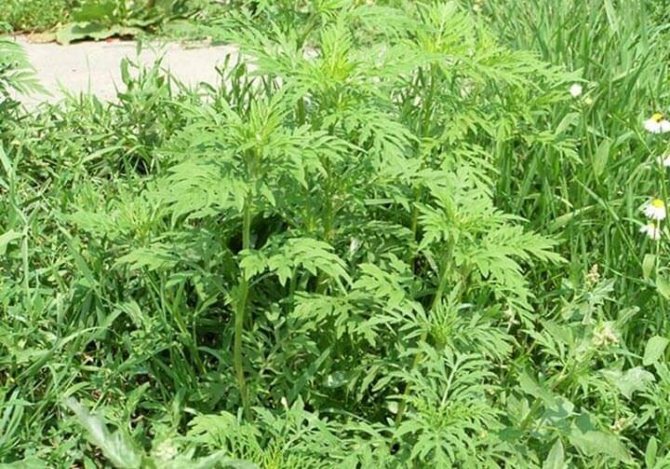
After a walk outside, you need to rinse your nasopharynx with boiled water and drink tea with added ginger. Ginger is considered the strongest remedy against allergies. Consuming activated carbon daily during the flowering period of ragweed will remove accumulated pollen and toxins from the body and reduce acute allergenic attacks.
Homemade ointment against allergies
If treatment is difficult, melt beeswax, interior fat (lamb, goose, chicken, pork, duck), vegetable or butter in turn. Mix the warm base with some tar and finely chopped laundry soap until smooth. Seal the container for storing the ointment and store in the refrigerator. Apply to problem areas of the skin for two weeks.
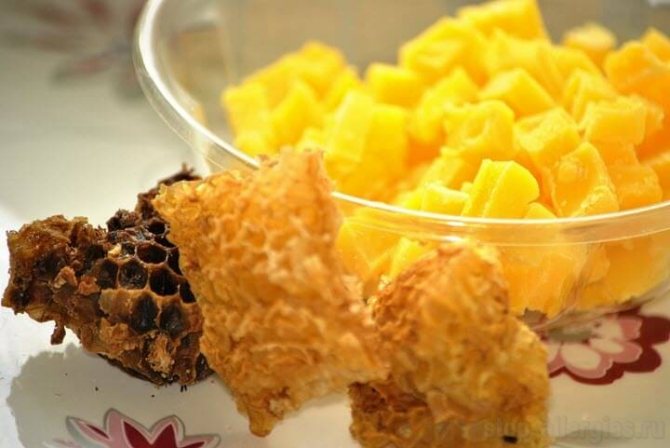
Collection to relieve a runny nose: mix horsetail, string, lemon balm, chamomile, and sage in equal parts. Steam in hot water, leave for half an hour, cool. Drink like tea. A propolis solution will help relieve a runny nose due to allergies. Apply drops to their nose twice a day. Make inhalations from decoctions of chamomile and calendula.
The drug mumiyo is effective in treating the disease. Dissolve one gram of the substance in boiled water, take 50 ml 4 times a day. Puffiness of the eyes will be relieved by compresses made from a mixture of cucumbers and raw potatoes, diluted in a small amount of cool water.
Classification
Depending on the location of the pathological process, the following are distinguished:
- allergic eye lesions ( allergic conjunctivitis );
- allergic diseases of the upper/lower respiratory tract ( allergic rhinitis / rhinosinusitis , bronchial asthma );
- allergic skin diseases - allergic (contact) dermatitis ;
- combined allergic manifestations ( rhinoconjunctival syndrome , allergic rhinitis + bronchial asthma/skin manifestations of allergies).
Based on the severity of clinical pollen allergies, it is customary to distinguish hay fever, which occurs in mild, moderate and severe forms.
Causes
The etiology of hay fever is determined by the climatic zone and the range of plants growing there. However, given the topic of the article, we will consider only the etiological factor in the form of weed pollen, which most often cause allergies in the Russian Federation: ragweed, wormwood, dandelion, quinoa. The main dusting period for Asteraceae (dandelion, wormwood, ragweed) and goosefoot (hemp, quinoa, cyclamen) is July-September. When does an allergy to ragweed end? Allergy to ragweed stops when the flowering period of the plant ends, and flowering ends in different areas at the end of September-October with a difference of 10-15 days.
Weeds produce a significant amount of pollen during the flowering period. Thus, one ragweed plant produces about 1 million grains per day; they can form entire clouds, upon settling of which the pollen can be collected manually. Pollen release occurs in the early morning, but its maximum concentration is reached in the afternoon/early evening, due to higher air circulation during this period of the day. Dry weather contributes to an increase in pollen concentration, and during rain/high humidity, in calm weather, the pollen concentration in the air decreases significantly. The allergenic properties of pollen persist for many hours. Photo of the plant below.
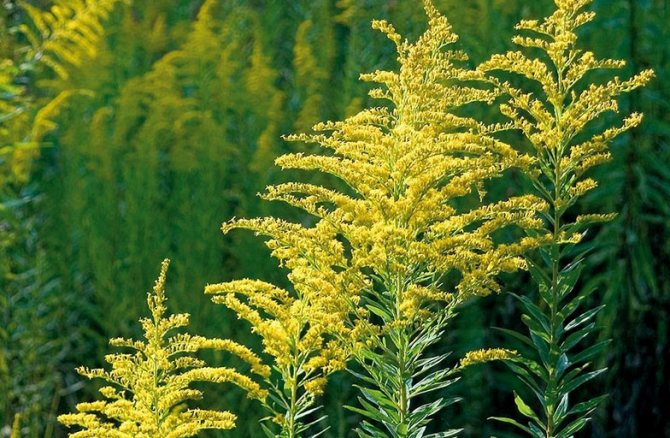
The outer shell of pollen grains has the most pronounced allergenic properties, which is due to the content of certain enzymes in it, which are of great importance in the process of interaction of pollen with environmental objects. The protein compounds responsible for the allergenicity of pollen are classified in chemical structure as polypeptides/glycopolypeptides, the molecular weight of which varies between 5000-40000 daltons. Relatively low-active antigens include those that contain large amounts of carbohydrates.
It has been revealed that damage to the mucous membranes is caused by the water-soluble fraction of the pollen allergen, and skin damage (contact dermatitis) is caused by the fat-soluble fraction, especially when it comes into contact with the skin. The presence of proteins in the composition of all pollen allergens explains the common antigenic properties of the pollen of plants related in structure.
Also a fairly common allergen is wormwood pollen. Allergy to wormwood (Chernobyl) is associated with the flowering period of wormwood, which occurs in July-September.

Allergy to wormwood and ragweed can also cause a cross-reaction (intolerance to related plant allergens, phytomedicines/food products). Variants of cross-reactivity of weed pollen are presented below.
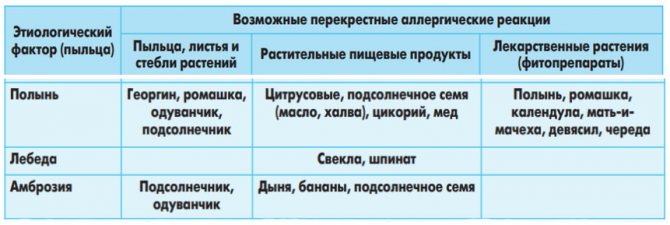
In addition, a number of people have an allergic reaction not only to weed pollen, but also to flowers of other plants, especially often to flowers from the Astrov genus: common chamomile, daisies, dandelions, sunflowers, coltsfoot. An allergy to chamomile can occur not only to its flowers, but also to its leaves. Also, plants with a strong aroma, such as bird cherry, lilies during the flowering period, and even indoor plants, such as geranium, can pose a certain danger. In addition, people with a history of allergies, as E. Malysheva says in her programs, may experience cross-sensitivity (allergies to house dust, medications, animal hair, odors, in particular to perfumes that use natural essential oils/oil extracts , preservatives, fragrance).
Factors that contribute to sensitization of the body:
- Negative heredity for atopic diseases.
- Place of birth/month of birth (region with a high concentration of pollen/birth of a child during the dusting season increases the likelihood of allergization of the body).
- Prematurity/low birth weight of the child, lack of natural feeding, frequent respiratory infections.
- Elevated levels of total serum IgE.
- Unfavorable atmosphere in places of residence/work.
- Poor nutrition.
When does ragweed season begin and end?
Ambrosia season is August-September.
But in addition to ragweed, we have such grass as cyclachena, which begins to bloom from the end of July. And also wormwood, which begins to gather dust from the first days of August. In most cases, patients are also allergic to these herbs. For most allergy-prone patients, it begins at the end of June and ends at the end of September.
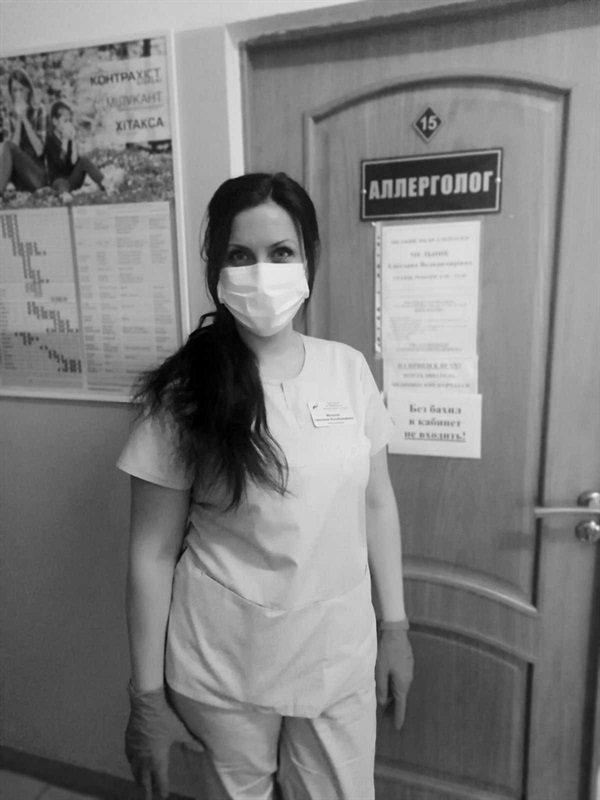
Symptoms of an allergy to ragweed
How does an allergy to ragweed manifest? Most often, hay fever to various plant pollens (chamomile, ragweed) manifests itself in the form of allergic rhinitis , allergic conjunctivitis , less often - in the form of pollen bronchial asthma , skin manifestations ( urticaria , dermatitis , Quincke's edema ) and extremely rarely manifests itself as damage to the gastrointestinal tract (epigastric pain , nausea, vomiting, stool disorders) and urogenital tract ( urethritis , cystitis , vulvovaginitis , nephritis ).
The specificity of clinical manifestations is the seasonality of their development. A direct correlation has been established between the severity of clinical symptoms and the intensity of plant dusting.
Typical symptoms in adults include rhinoconjunctival syndrome in the form of redness/itching of the eyes, photophobia, lacrimation, sensation of a foreign body in the eyes, and in severe cases, blepharospasm . At the same time, a profuse runny nose, itching in the nose, ear canals/nasopharynx, sneezing attacks, varying degrees of unilateral/bilateral difficulty in nasal breathing, maceration/hyperemia of the skin of the wings and vestibule of the nose, and olfactory disorders (hypoosmia/anosmia) may be present. When the sinuses, auditory tubes, nasopharynx, and larynx are involved in the pathological process, symptoms of pharyngitis , eustachitis , and laryngitis .
In cases of a progressive course (after 3-5 years on average), from the onset of the disease, seasonal pollen bronchial asthma , combined with allergic rhinoconjunctivitis , may develop from the onset of the disease, however, in rare cases, bronchial asthma can manifest itself in isolation and be the only clinical manifestation of the disease. In this case, BA is characterized severe course and gradual formation of asthmatic status.
During the season of active dusting of causally significant plants, some patients suffering from hay fever complain of increased fatigue, headache , sweating , severe weakness, chills , hyperthermia , irritability, sleep disturbance ( drowsiness / insomnia ), tearfulness, and sometimes low-grade fever.
These symptoms in various combinations in severe hay fever form an asthenic syndrome caused by “pollen intoxication.”
Skin manifestations of allergy are relatively rare, mainly in the form of contact urticaria / atopic dermatitis , less often - contact dermatitis upon contact with the stems / leaves of plants and manifests itself in the form of hyperemia in the affected areas followed by rashes in the form of vesicles.
In the presence of cross-reactivity, which affects 40-76% of patients with hay fever, clinical symptoms manifest as gastrointestinal symptoms, oral allergy syndrome, acute urticaria or angioedema . Much less often - anaphylactic shock . Patients complain of tingling, itching and swelling of the tongue, lips, pharynx, palate, and a feeling of a lump in the throat when swallowing products that contain cross-reacting allergens. Gastrointestinal symptoms (nausea, abdominal pain, vomiting, diarrhea, intestinal colic) are less common.
A number of patients may experience changes in the nervous/cardiovascular system, which are functional in nature and are not recorded outside the flowering period. Disturbances caused by pollen allergies include increased blood pressure , tachycardia , systolic murmur at the apex, and muffled heart sounds.
Symptoms of ragweed allergy in children are similar. The severity of seasonal manifestations is determined by the duration of the pollen season, the concentration of pollen in the air, and individual sensitivity. It should also be taken into account that even after a decrease in the concentration of pollen in the air, a number of patients over a long period experience repeated manifestations of hay fever, a nonspecific response to various factors, for example, a strong odor (perfume), changes in temperature, air pollution, etc.
General Tips
These recommendations can help not only those with allergies to ragweed, but also those with allergies to pollen from other plants.
- Take a shower and wash your hair as often as possible. Ideally, this should be done twice a day;
- Try to ventilate rooms using an air conditioner with a built-in dust filter. If there is none, put a net over the windows;
- Install a humidifier in the room;
- Regularly carry out wet cleaning of the apartment;
- If possible, wait out the allergy season in another region.
Like any disease, an allergy to ragweed brings many problems. But proper and timely treatment can not only greatly reduce the symptoms, but also completely cure you of this disease. And then summer will truly become a time of happiness for you.
Be healthy!
Tests and diagnostics
Diagnosis of hay fever, as a rule, is not difficult and includes the study of an allergic history with the establishment of the characteristic seasonality of exacerbations, the presence of characteristic symptoms and the effectiveness of antihistamines. To confirm the diagnosis, skin tests (scarification, injection) with specific allergens and provocative tests (eye/nasal) are performed, which allows you to clearly identify the allergen. In some cases, other methods can be used - immunoenzyme, provocative, radiallergosorbent, etc.).
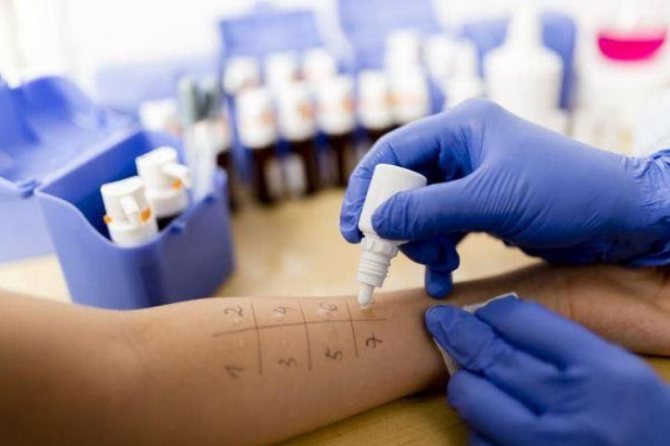
Diet
Hypoallergenic diet
- Efficacy: therapeutic effect after 21-40 days
- Timing: constantly
- Cost of products: 1300-1400 rubles. in Week
Diet for allergies in children
- Efficacy: therapeutic effect after 15-21 days
- Time frame: until the allergic reaction to the food allergen disappears
- Cost of products: 1500-1600 rubles. in Week
Hypoallergenic diet for nursing mothers with child allergies
- Efficacy: therapeutic effect after 30 days
- Timing: constantly
- Cost of products: 1600-1700 rubles. in Week
During the dusting period, when the allergenic load on the body increases many times over. It is extremely important to follow a strict hypoallergenic diet until all symptoms disappear, which involves, first of all, excluding from the diet foods that have high allergenic activity (chicken eggs, whole milk cow's milk, crustaceans, cheese, chocolate, fish, mustard, coffee, citrus fruits, pineapples, honey, nuts, strawberries, raspberries, wild strawberries, cocoa, grapes, persimmons, tomatoes, mushrooms, celery, beets, pomegranates, melon, carrots, blackberries, black currants, red caviar, spices, smoked meats, sauces, pickled/canned foods, carbonated drinks) .
Despite significant restrictions in the diet during the acute period of the disease, nutrition should be physiologically complete in terms of macro/micronutrient content and energy value. Almost 90% of people who suffer from hay fever have a cross-intolerance (reaction) to food products that have allergens similar to weed pollen. Such products should be excluded from the diet.
What can't you eat?
During the flowering period of Asteraceae/Chenopodia weeds (from late July to September/October), the following should be excluded from the diet:
- melons (watermelons/melons);
- bee products (honey, pollen, propolis, royal jelly);
- sunflower seeds and products containing them (mayonnaise, sunflower halva, mustard);
- spices/herbs (pepper, cinnamon, anise, cumin, nutmeg, curry, dill, celery, parsley, ginger, coriander);
- alcoholic drinks prepared with the inclusion of wormwood and plants close to it: vermouth, absinthe, balsams;
- chicory.
There may be a reaction to garlic, carrots, citrus fruits, bananas. If you are allergic to quinoa pollen, avoid spinach and beets. As for herbal remedies, you cannot use products containing chamomile, calendula, wormwood, coltsfoot elecampane, string, dandelion, yarrow, tansy.
You can learn more about nutritional recommendations for patients with allergies in the articles “Hypoallergenic diet”, “Diet for allergies in children” and “Hypoallergenic diet for nursing mothers with allergies in a child”.
Is it possible to attend school and kindergarten with allergic rhinitis?
Of course you can. Going to school or kindergarten is not contraindicated. The patient takes medications and controls his condition. If you came into contact with pollen somewhere and sneezed or coughed, then there is nothing wrong with that - after all, it is not contagious.
Nowadays, schoolchildren often turn to us for information about hay fever. Perhaps parents are worried that their children will not be allowed to go to school with a runny nose. But if a child suffers from hay fever every year in September, then he is already registered with a pediatrician. You don’t have to go to an allergist for help. You should go to an allergist if you need medical help or if you are being diagnosed for the first time.
Prevention
The main preventive measures include measures aimed at eliminating pollen allergens, which include:
- If possible, change the climatic zone/terrain during the flowering period of weeds to which the patient is sensitized.
- Limitation of walks/excursions into the “green zone”.
- Change of clothes immediately after walks, shower.
- Wearing a respirator mask and dark glasses.
- Using indoor air conditioners.
- Exclusion from the diet of foods with cross-allergenic properties and herbal medicine.
Flowering period
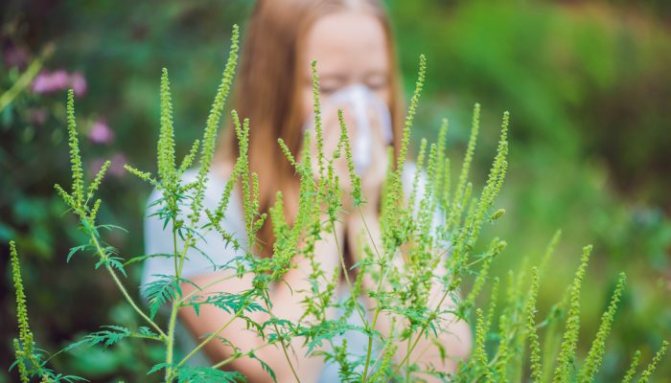
Unpleasant symptoms begin to torment allergy sufferers when ragweed begins to bloom. But the timing of the appearance of pollen in the air in different regions is somewhat different:
- In the south, single flowers may appear already in the first months of summer. And flowering usually lasts until October. Of course, at the beginning of this period and towards the end, the concentration of pollen in the air is not too high; the peak of flowering occurs at the end of July and lasts until the end of September.
- The further north you go, the later ragweed begins to bloom, and the sooner it stops causing discomfort to humans.
Even residents of regions where ragweed has never existed can suffer from an allergy to this plant. The reason for this is the wind, which easily carries clouds of pollen hundreds and thousands of kilometers.
Consequences and complications
The most common complication of hay fever is bacterial conjunctivitis and keratoconjunctivitis . The development of a systemic allergic reaction in the form of angioedema , angioedema or anaphylactic shock is extremely rare. The course of hay fever can be complicated by “pollen intoxication,” which is manifested by decreased appetite, headache , fatigue, and nausea. With inadequate therapy, there is a risk of chronicization of the allergic process, the development of bronchial asthma , exacerbation of existing diseases, and the development of cross-forms of allergies.
How to distinguish allergies from COVID-19?
First, we ask the patient about the situation. For example, if a patient develops rhinoconjunctivitis every August, then first of all we think about an exacerbation of the seasonal disease. If the patient has been in contact with coronavirus patients, or has been to countries or regions where the epidemic threshold for morbidity has been exceeded, then we will consider the likelihood of COVID-19.
Secondly, we pay attention to the symptoms - with allergies they are not the same as with COVID-19. With coronavirus, there will be no runny nose or watery eyes, but congestion, loss of smell, taste, and fever. The latter is extremely uncharacteristic of allergic reactions; the temperature during allergies can increase only in the case of severe forms of the disease.
List of sources
- Allergology and immunology. National leadership / Ed. R.M. Khaitova, N.I. Ilyina. - M.: GEOTAR-Media, 2009. 656 p.
- Goryachkina L.A., Peredkova E.V., Bzhedugova E.R. Treatment of hay fever // Attending physician, 2004, No. 3, p. 22.
- Gushchin I. S. Prospects for the treatment of allergic diseases: from antihistamines to multifunctional antiallergic drugs. IX Russian National Congress “Man and Medicine”. M., 2002, p. 224–232.
- Gushchin I. S., Kurbacheva O. M. Allergen-specific immunotherapy of atopic diseases: A manual for doctors. – M., 2002. – P.32.
- Ilyina N. I., Kurbacheva O. M. Modern pharmacotherapy of hay fever: safety and effectiveness // Consilium Medicum. – 2003.–T. 5. – No. 4. – pp. 226–231.

